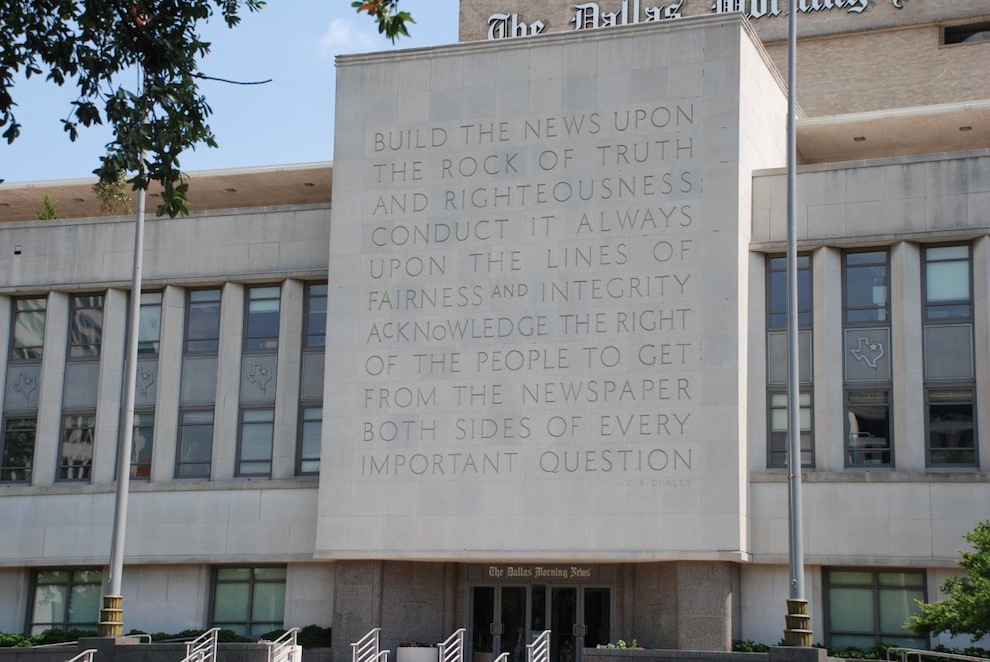

If 2012 was the Year of the Paywall for American newspapers, 2013 is turning into the Year of Paywall Tinkering.
Last month, it was The New York Times that announced it planned to diversify its digital subscription model with a set of lower- and higher-priced offerings — “to use a wider family of New York Times products to reach new customers,” as NYT Co. CEO Mark Thompson put it. And there was the Orange County Register offering up its own unique spin on a hard paywall.
The latest newspaper to tweak its model is The Dallas Morning News. The Texas paper debuted its paywall in March 2011, a hair before the Times, and it was on the harder end of the paywall spectrum — no meter, with content sharply divided into available-to-all and available-to-subscribers tranches.
But now the Morning News plans to tinker with that paywall to try to capture a larger readership. Publisher Jim Moroney says the company is exploring its options — including adding a meter that would allow for a limited number of free stories, creating specialized tiers of digital access to Dallasnews.com, or creating time-limited access to the site, like a 24-hour pass.
 “We didn’t really give people enough reasons to subscribe digitally. We made it too hard for them to subscribe digitally. We didn’t market it hardly at all,” Moroney told me.
“We didn’t really give people enough reasons to subscribe digitally. We made it too hard for them to subscribe digitally. We didn’t market it hardly at all,” Moroney told me.
Moroney wouldn’t go into specifics on what the new model would look like, only to say they want to launch the new system later this year that would be a “greatly improved, metered paid-access model that is much more consumer friendly in every way.”
Last week A.H. Belo, parent company of the Morning News, announced that digital revenue had increased 12 percent — that includes both advertising and marketing services — for the first quarter of 2013 over 2012. (At the Morning News, the numbers were better — up 31.7 percent.) Meanwhile, circulation revenue at both A.H. Belo and the Morning News was down 7 percent. (The quarterly report did not break out digital circulation revenue from print.)
That dropping circulation number might be why the Morning News, much like the Times, is now trying to develop additional access options to gather up nonsubscribers. But Moroney says the reasons for diversifying the digital model have become more complex. Before, papers like the Morning News thought they had to bundle digital access with the paper to stop print readers from flocking to the web for free news, Moroney said. The reality is that a certain base of newspaper readers are going to subscribe regardless, he said. “The research we did said our core print subscribers do not consider all-digital access as a substitute for print,” he said. “They see it as an add-on.”
That research, Moroney said, indicated that 85 percent of the Morning News print-only subscribers want access to digital on top of their daily paper. Through bundling digital and print access, and price increases in print since 2008, Moroney said the company has pushed out marginal subscribers, leaving a dedicated “hard-core” base of subscribers. The task now is to tap into a broader audience of people who want digital-only access to the Morning News, he said. “The question is, again: Are there people who have no interest in the newspaper who are willing to pay you to access what you publish digitally?” Moroney said.
While the Morning News wants to increase revenues through the subscription model, the company clearly recognizes that digital circulation alone won’t be enough to support a media company. In the last two years the Morning News has either acquired or launched a handful of digital businesses, including 508 Digital, the marketing services firm designed for local businesses; Pegasus News, a local entertainment and news site; and Speakeasy, a social marketing and events agency.
The overall goal, Moroney said, is transitioning from an advertising-dependent model to a consumer-supported business. It’s a trend the rest of the industry has been moving towards. Moroney says they expect the revenue generated by new businesses will offset the projected decreases in print advertising revenue in 2013. Even as those new endeavors help lift the bottom line for the Morning News, Moroney said it remains important that each business remain separate and distinct in order to grow. In other words, just because money is coming through other doors at the company doesn’t mean the news division is any less important — or has any less of the pressure to be self sufficient.
“I believe that the survival of our business is predicated on one thing: the ability for me to publish a sufficient amount of relevant, unique content that the consumer can’t get anywhere else,” Moroney said.
Photo of the Rock of Truth (Dallas Morning News HQ) by kthread used under a Creative Commons license.